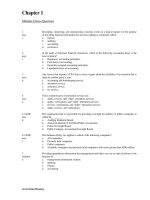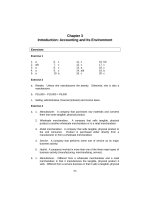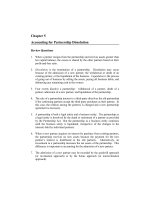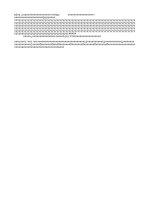Solution manual fundamentals of accounting by cabrera chapter 03
Bạn đang xem bản rút gọn của tài liệu. Xem và tải ngay bản đầy đủ của tài liệu tại đây (70.76 KB, 3 trang )
Chapter 3
Introduction: Accounting and Its Environment
Exercises
Exercise 1
1.
2.
3.
4.
5.
a
a/b
a
a
a
6.
7.
8.
9.
10.
c
c
c
c
a
11.
12.
13.
14.
15.
c
c
a
a/b
c
16.
17.
18.
19.
20.
b/c
c
c
b
c
Exercise 2
a. Retailer. Unless she manufactures the jewelry. Otherwise, she is also a
manufacturer.
b. P15,000 – P10,000 = P5,000
c.
Selling, administrative, financial (interest) and income taxes.
Exercise 3
a. 1. Manufacturer. A company that purchases raw materials and converts
them into some tangible, physical product.
2. Wholesale merchandiser. A company that sells tangible, physical
product to another wholesale merchandiser or to a retail merchandiser.
3. Retail merchandiser. A company that sells tangible, physical product to
the end consumer.
Product is purchased either directly from a
manufacturer or from a wholesale merchandiser.
4. Service. A company that performs some sort of service as its major
business activity.
5. Hybrid. A company involved in more than one of the three major types of
business activity (manufacturing, merchandising, service).
b. 1. Manufacturer. Different from a wholesale merchandiser and a retail
merchandiser in that it manufactures the tangible, physical product it
sells. Different from a service business in that it sells a tangible, physical
3-1
2
Chapter 3
product. Different from a hybrid business because it manufactures and
nothing else.
2. Wholesale merchandiser. Different from a manufacturer because it buys
its tangible, physical product already made. Different from a retailer
because it does not sell its product to the end consumer. Different from a
service business because it sells a tangible, physical product. Different
from a hybrid business because it sells wholesale and nothing else.
3. Retail merchandiser. Different from a manufacturer because it buys its
tangible, physical product already made. Different from a wholesaler
because it only sells its product to the end consumer. Different from a
service business because it sells a tangible, physical product. Different
from a hybrid business because it sells retail and nothing else.
4. Service. Different from a manufacturer, wholesaler and retailer in that it
does not sell any tangible, physical product. Different from a hybrid
business because it performs a service and nothing else.
5. Hybrid. Different from all the other four because while each of them
performs a single function (manufacturing, wholesaling, retailing, or
service), this type of business performs at least two of those functions.
c.
Note to Instructor: There is no way either we or you can anticipate your
students’ answers to this requirement. You will simply have to evaluate their
answers based on your own experience and judgment.
Wholesale
merchandise will likely be the most difficult for students to come up with and
the most difficult for you to evaluate.
Exercise 4
a. Professor Francisco is proposing to form a corporation. We can determine
this because he will be selling shares of stock. A corporation is the only one
of the three principal forms of business organization that issues shares of
stock.
b. 1. Limited liability. The maximum amount a shareholder can lose is the
amount of his or her investment.
2. Greater access to capital. Corporations can attract a great number of
investors by dividing ownership into relatively low-cost shares of stock.
3. Easy transferability of ownership. Because shares of stock are usually
relatively low in cost, they can be purchased and sold by individual
3-2
Role of Accounting in Business
3
investors much more easily than ownership interests in either
proprietorships or partnerships.
4. Continuity of life. A corporation continues to exist even when there is a
complete change in ownership. The transfer of shares of stock from one
investor to another has no effect on a corporation.
Exercise 5
1.
2.
3.
4.
5.
S
S
T
AA
Y
6.
7.
8.
9.
10.
I
G
R
A
K
11.
12.
13.
14.
15.
M
Q
F
C
P
Exercise 6
a.
b.
c.
d.
e.
f.
g.
S, P, C
S, P
C
S, P
C
S, P
C
Multiple Choice Questions
1.
2.
3.
4.
5.
c
c
c
a
c
6. d
3-3
16.
17.
18.
19.
20.
X
B
H
Z
C
21.
22.
23.
24.
25.
U
O
FF
D
EE









